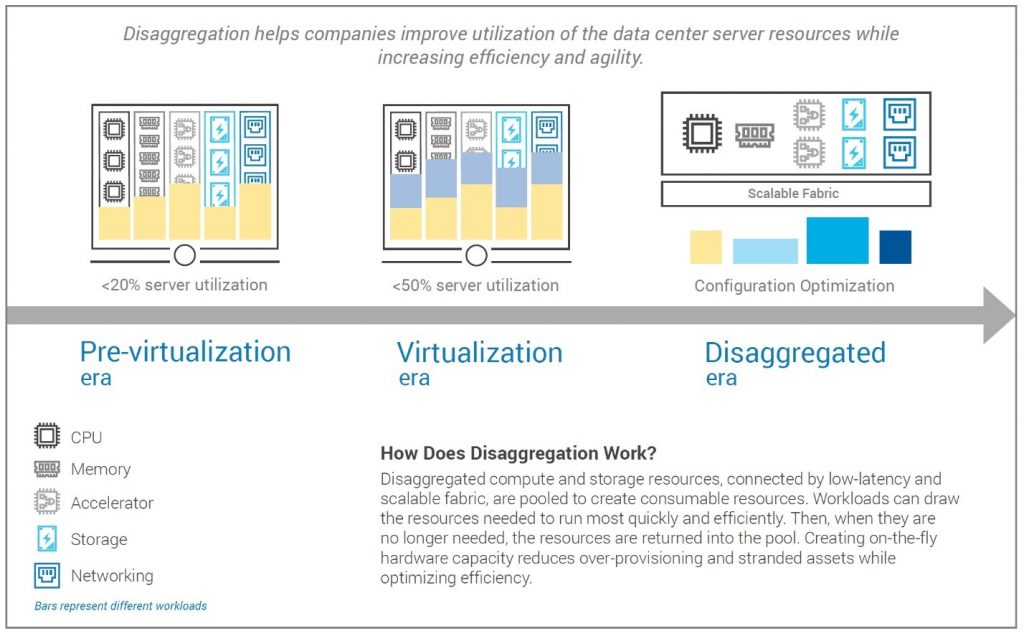“The only thing that is constant is change.”
When Greek philosopher Heraclitus uttered this timeless phrase, it’s safe to say he wasn’t referring to the workloads in your data center. But here we are, some 2000+ years later, and his wisdom still rings true. Our world continues to evolve, with technology a prime example.
In the past, IT departments primarily focused on traditional workloads such as file, print, web serving and virtual desktop. Clearly these will always be important, but in today’s digital economy they are no longer enough. To remain relevant in this environment of constant change, IT departments must shift from their traditional mindset to help drive the overall business strategy. With the emergence of new, data-fueled workloads such as IoT, AI and machine learning, IT is poised to play a huge role in their company’s economic success.
“Modernized IT organizations are adopting modular infrastructure at a rate 4x greater than their aging counterparts.”
From Pre-Virtualization Era to Disaggregation Era
There is a shift underway in the world of enterprise technology. IT infrastructure transitioned from a pre-virtualization era, into a virtualization era and now toward an era of disaggregation.

In the pre-virtualization era, data centers operated mainly in silos, often leaving resources stranded. It was inefficient, complex and difficult to manage. These silos made it hard to handle multiple workloads and scale quickly – not to mention expensive to maintain.
Now, as we transition from a virtualization era into an era of disaggregation, IT departments are challenged to keep up with the accompanying demand for disaggregated compute. Unfortunately, many IT departments have not yet embraced the change, and those that are unable – or unwilling – to adapt are beginning to suffer the consequences.
However, organizations that understand the importance of adapting to change are increasingly taking actions to position themselves for success. One way they prepare is by including modular infrastructure in their data center. In fact, modernized IT organizations are adopting modular infrastructure at a rate 4x greater than their aging counterparts. Increased scalability, improved flexibility, and easier manageability are the most-commonly identified benefits of using modular servers. They can adapt quickly to changing workload demands and help break down IT silos, so that IT can focus on innovation and other tasks that help them reach their business goals.
Ultimately, the end goal of modern IT is to combine the benefit of modular design with an extended flexibility of configuration at the individual storage device and all the way to memory centric devices. Dell EMC refers to this fully disaggregated state as kinetic infrastructure. A kinetic infrastructure enables the ability to dynamically assign the right resources for the right workload.
The Dell EMC Kinetic Solution: PowerEdge MX
Transformational workloads (i.e. structured data analytics, unstructured data analytics (cognitive/AI), and cloud-native applications) require an enormous amount of data, and companies must be set up to handle it. Kinetic infrastructure helps companies capitalize on their potential by providing a flexible platform that can handle vast amounts of data and evolve in accordance with changing workload requirements.
Dell EMC recently launched PowerEdge MX, the first modular platform designed with kinetic infrastructure. It provides the flexibility, agility and responsiveness needed to bridge demands of traditional and transformational workloads. Combining compute and storage, connected by scalable fabric, this 7U chassis with integrated systems management software creates shared resources pools that can be dynamically allocated and reallocated as needed for optimum workload performance.
PowerEdge MX dynamically configures compute, storage and fabric and accelerates operations, delivering the innovation and longevity customers of all sizes need for their IT and digital business transformations. It’s flexible, agile and responsive – all key components of a modernized data center.
PowerEdge MX is designed for today’s software-defined data center and provides a solid foundation for your IT transformation. It helps IT break free from traditional boundaries to transform the IT infrastructure to a dynamic pool of instantly responding, adapting and evolving resources. With a modern IT infrastructure anchored by the PowerEdge MX, plus strategic planning and careful preparation, companies can position themselves to succeed both today and in the future.
The world is changing, ready or not. Businesses that prioritize flexibility and learn to adapt to an ever-evolving IT environment are more likely to innovate and succeed in the future. After all, in the wise words of Heraclitus, “Big results require big ambitions.”
To learn more about kinetic infrastructure, read How Dell EMC Kinetic Infrastructure Solutions Accelerate Business Innovation.
[1] Source: ESG White Paper commissioned by Dell EMC, Insights from Modernized IT: Modular Compute Can Have a Big Impact, August 2018
